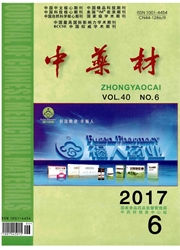

 中文摘要:
中文摘要:
目的探讨丹参提取物对糖基化终末产物(AGEs)/缺氧条件下视网膜Müller细胞低氧诱导因子-1α(HIF-1α)表达的药理作用与化学成分之间的关系,并以丹参酮IIA为对照,初步探索丹参治疗糖尿病性视网膜病变(DR)的药效物质基础。方法采用HPLC法建立10批丹参提取物的指纹图谱,获得各特征峰的峰面积。在AGEs/缺氧条件下培养视网膜Müller细胞,并测定丹参提取物给药组及丹参酮IIA对照组HIF-1α的表达量。结合灰色关联分析法与偏最小二乘法回归分析成分与药效之间的谱效相关性。结果根据10批样品指纹图谱共标示出17个特征峰。与模型组相比,10批样品及丹参酮IIA对照组均能降低视网膜Müller细胞HIF-1α的表达量。谱效相关性研究显示峰1、5、6、9、10、11、12、14、15、16代表的化学成分对抑制HIF-1α表达具有较大的贡献。结论初步确定15,16-二氢丹参酮I、隐丹参酮、丹参酮I、丹参酮IIA及6个尚未确定结构的成分(峰1、5、6、9、14、15)为丹参治疗DR的可能药效物质。
 英文摘要:
英文摘要:
Objective To investigate spectrum-effect relationship of the extract from Salvia miltiorrhiza on HIF-1α of retinal Miiller cells in the advanced glycationend products (AGEs) or hypoxia conditions, regarding tanshinone IIA as reference to explore the relationship between pharmacological effects and chemical substances, and to reveal the material basis of S. miltiorrhiza treating diabetic retinopathy (DR). Methods Fingerprints of different S. miltiorrhiza extract were established by HPLC and characteristic peak's area was recorded. After that, the expression quantity of HIF-1α of retinal Mtiller cells were tested in the AGEs or hypoxia conditions under the two different conductions: S. miltiorrhiza extract or only tanshinone IIA. Gray relational analysis and partial least squares regression analysis (PLSR) were combined to build spectrum-effect relationship. Results Seventeen characteristic peaks were marked out. Compared with the model set, 10 batches of extracts and tanshinone IIA could lower the expression quantity of HIF-1α. The statistical results showed that the peaks 1, 5, 6, 9, 10, 11, 12, 13, 14, 15, and 16 would inhibit HIF-lct expression, which made great contribution. Conclusion The 15,16-dihydrotanshinone I, cryptotanshinone, tanshinone I, tanshinone IIA, and other six components might be the main effective components in the ethanol extract from S. miltiorrhiza.
 同期刊论文项目
同期刊论文项目
 同项目期刊论文
同项目期刊论文
 Chemical Changeability of Essential Oils in Chenpi and Qingpi from the Same Origin by Gas Chromatogr
Chemical Changeability of Essential Oils in Chenpi and Qingpi from the Same Origin by Gas Chromatogr 期刊信息
期刊信息
